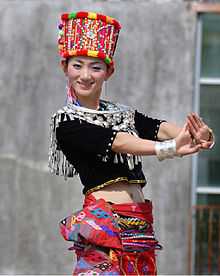Singpho people

The Singpho/Jingpho/Kachin/Jinghpaw are a tribe who are inhabiting in India, China and Myanmar. In India these people are residing in the state of Arunachal Pradesh in the district of Lohit and Changlang and in Assam inhabits in the district of Tinsukia and scattered in some other district like Sivasagar, Jorhat and Golaghat, the Kachin State of Burma and Dehong of Yunnan Province, China . Comprising a population of at least 7,200 in India, they live in the villages, namely Bordumsa, Miao, Innao, N-hpum, Namgo, Ketetong, Pangna, Phup, N-htem, Mungong, Kumchai, Pangsun, Hasak, Katha, Bisa, Dibong, Duwarmara, Namo and Namsai, etc. The Singpho are the same people as those called the Kachin in Burma and the Jingpo in China.[1] They speak the Singpho dialect of the Jingpo language.
The Singphos are divided into a number of clans, each under a chief known as a Gam. The principal Gams include the Bessa, Duffa, Luttao, Luttora, Tesari, Mirip, Lophae, Lutong and Magrong. The Singpho are also divided into four classes, namely Shangai, Myung, Lubrung and Mirip.
Religion
Like the Khampti, the Singpho are mainly Theravada Buddhist by religion. Animism is also widely followed in this community. The ancestor of all the Singpho, who is worshiped as a spirit or god, is held to be named Madai. Singpho Animists believe that spirits reside everywhere, from the sun to the animals, and that these spirits bring good or bad luck. For the Singpho, all living creatures are believed to have souls. Rituals are carried out for protection in almost all daily activities, from planting of crops to warfare.
Lifestyle
Unlike most hill-people, shifting cultivation (Jhum) is not as widely practised, although tea is widely planted. Singpho people were the one who gave British the idea of tea. The Singpho produce their tea by plucking the tender leaves and drying them in the sun and exposing to the night dew for three days and nights. The leaves are then placed in the hollow tube of a bamboo, and the cylinder will be exposed to the smoke of the fire. In this way, their tea can be kept for years without losing its flavour. The Singpho also depended on yams and other edible tubers as their staple food.
Dress
The Singpho made shields from buffalo hide, many of them can be as long as four feet. They also have helmets are made from either buffalo hide or rattan-work, and vanished black and decorated with the boar's tusks. Most men tie their hair in a large knot on the crown of the head. The women dress their hair gathered into a broad knot on the crown of the head, fastening it by silver bodkins, chains and tassels, which is similar to the architecture of the modern skyscrapers. The maidens tie their tresses into a roll and keep it tied just above the nape. Singpho dwellings are usually two stories and built out of wood and bamboo. The houses are of oval form; the first floor serves as a storage and stable while the second is utilized for living quarters. Women often dress in black jackets with silver decorations during festival known as Munao Poi. This dress are one of the most beautiful and attractive dress in Northeast India. They also wear wool skirts made in bright red colors. The men often wear a white shirt with colorful Lungi, covering their heads with turbans.
The Opium Controversy
The consumption of opium was a traditional practice among the Singpho, and it can be witnessed that the opium has severely harmed the fertility among the tribesmen. According to the 1950 census, the population of the Singpho tribe has fallen from 50,000 to less than 10,000 in recent years.[2] With the free trade of opium between India and Burma since the signing of the bilateral trade in 1995, extreme abuse of opium have been reported since of 1997, especially in the villages of Pangsun and Kumsai. Cases of selling off their properties for the sake of buying opium was widespread in recent years. Many of these addicts consumed opium by smoking wooden and bamboo pots known as Doba, although injection of needles is also used. Most of these addicts take twenty grams, or even higher amounts of opiums. According to one villages, opium used by the Singpho is supplied by members of the Tangsa tribe living just across the Burmese border.
The Indian government had also responded to the problem. Of late, they have established laws of jail terms and rehabillation centers for opium addicts. The Singpho National Council also have plans to set up posts to restrict of the opium inflow into India.
Notes
References
- Bradley, David. (1997). Tibeto-Burman languages of the Himalayas. Canberra: Australian National University Press. 10-ISBN 0858834561/13-ISBN 9780858834569; OCLC 37646449
- Prandey, B. B. Pandey and D. K. Duarah. (1991). Myths and Beliefs on Creation of Universe Among the Tribes of Arunachal Pradesh. Itanagar, Arunāchal Pradesh (India): Directorate of Research, Government of Arunachal Pradesh. 10-ISBN 817516106X/13-ISBN 9788175161061; OCLC 50424420
External links
- Kachin National Organization
- The Kachin of Burma
- Singpho: Victims of India
- Art and crafts of the Singpho
- Ethnologue profile
- Christianity Overwhelming Buddhism in India's North-East
| ||||||||||||||